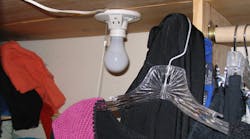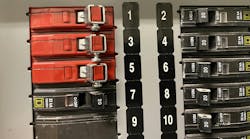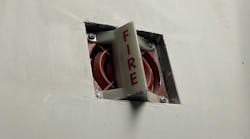How well do you know the Code? Think you can spot violations the original installer either ignored or couldn't identify? Here's your chance to moonlight as an electrical inspector and second-guess someone else's work from the safety of your living room or office. Brian, who has a knack for finding shoddy electrical work, did the dirty work and found this mess. Now it's your turn to identify the violation.
Find the Answer
This installation is one that represents a tremendous fire hazard. The use of "open" incandescent fixtures has long been prohibited by the NEC, and for good reason. As most of you are aware, an incandescent lamp is a better heater than a light source. Locating them in close proximity to easy ignitable material, such as clothing within a closet, is highly objectionable. Additionally, if this bulb were to break after being energized for a period of time, it would spill hot glass and tungsten all over the clothing below, which could start a fire.
In the 2008 edition of the NEC, the requirement of 410.16(B) clearly identifies such an installation as unacceptable. The rule states, "Incandescent luminaires with open or partially enclosed lamps and pendant luminaires or lampholders shall not be permitted."
In addition, rule 410.16(C) stipulates the areas within a clothes closet where a fixture may be located. Item (3) only recognizes "recessed incandescent…luminaires" where installed at least 6 in. from the "nearest point of storage area." This wording does not recognize the use of surface-mounted incandescent fixtures in the ceiling. In fact, this rule indicates that only recessed-type incandescent luminaries may be installed in the ceiling of a closet.
Another concern with this particular installation is the wiring method used to supply this luminaire. The use of flexible cord (i.e., zip-cord) to supply any load, much less a porcelain lampholder in a clothes closet, is rightly limited by the Code.
Section 400.8 outlines where flexible cord may not be used. Here, while it's not seen in the picture, the flexible cord is essentially being used as "a substitute for fixed wiring," which violates 400.8(1). And, since item (3) prohibits running flexible cord "through doorways, windows, or similar openings," we can cite this as another violation. Lastly, the fourth subpart to the rule, 400.8(4), states that flexible cords and cables may not be "attached to the building surfaces," with the exception of bus-drop cable. As can be seen, this "electrician" was so conscientious that he stapled the zip cord to the ceiling. Great move!




